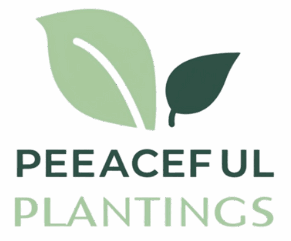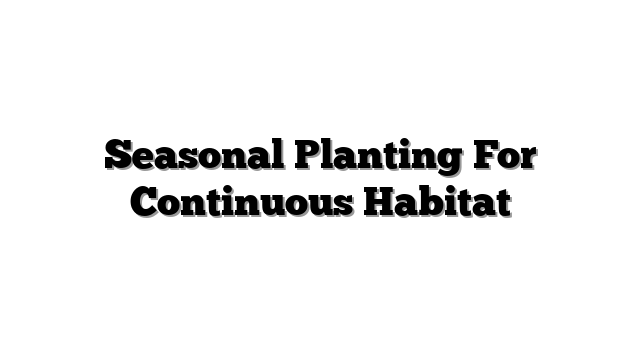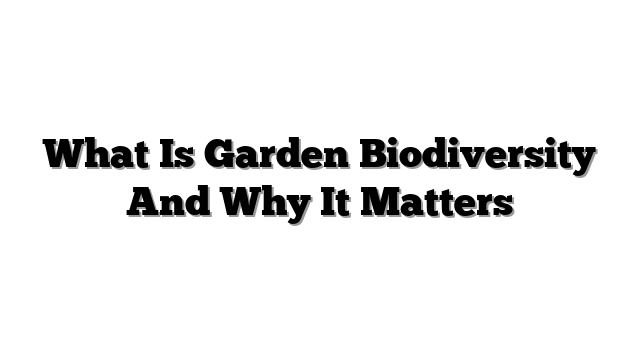Seasonal Planting For Continuous Habitat
Your garden holds great promise. It can be more than just pretty flowers. Imagine a place full of life. Birds sing. Bees buzz. Butterflies visit often. This happens all year long. Not just in summer.
Many gardens look nice for a short time. They bloom brightly in one season. Then they look empty. Wildlife finds no food then. They find no safe place. We miss a chance. A chance to help nature. Nature needs help always.
Seasonal planting changes this. It means planting for every season. Your garden becomes busy. It stays busy 365 days. It feeds and shelters wildlife. It becomes a strong place for nature.
We will explore seasonal planting. We will see what habitat means. We will plan a garden. We will pick plants for each season. We will learn simple care. We will add special spots for animals.
This guide will help you. It shows you how to start. You can make a garden home. A home for many creatures.
Why Your Garden Matters: Building a Year-Round Habitat
Home gardens are very important. They connect natural areas. Think of them like tiny parks. They help animals move safely. This is true in cities. It is true near houses.
Animals need basic things. They need four main things. These things make a habitat.
They need food. Flowers give nectar. Bees drink it. Flowers give pollen. Bees eat it. Plants make seeds. Birds eat seeds. Bushes grow berries. Animals love berries. Leaves feed caterpillars. Caterpillars turn into butterflies. Insects feed birds.
Animals need water. They need to drink. They need to bathe too. A small dish helps. A bird bath is good.
Animals need shelter. They hide from animals that hunt them. They hide from bad weather. They need places to build nests. They need places to sleep safely. They need places for winter.
Animals need space. They need room to find food. They need room to raise babies. They need room to move around.
Many kinds of plants help. More plant types mean more animals. Tall trees help birds. Small bushes hide rabbits. Small plants cover the ground. Different animals use different layers.
Food and shelter change. They change with the seasons. Winter is hard. Planning helps. Seasonal planting gives food always. It gives shelter always.
People care more now. They want to help nature. A recent study shows this. More people garden for wildlife. This helps local animals greatly. Your garden makes a difference.
Observe your garden now. See what animals visit. What do they use? What do they need more of? This helps you start.
Designing Your Wildlife Haven: Planning for Year-Year Appeal
Good planning makes a difference. It helps you build a great garden. Think about what animals need. Plan for them from the start.
Look at your garden space. How much sun does it get? Some spots have full sun. Some have shade. Some have sun part of the day. This matters for plants.
Check your soil. Is it sandy? Is it clay? Does water drain well? Healthy soil grows healthy plants. Healthy plants feed animals better.
Look at what is there now. Are there trees? Are there buildings? Is there water? These things matter.
Where does wind blow? Strong wind can be bad. Plants and animals need protection.
Map your space simply. Draw where the sun is. Draw where things are now. Plan where to put food. Plan where to put water. Plan where to put shelter. Put them where animals can find them.
Think about layers. Tall plants are one layer. Medium bushes are another. Small plants are a layer. Low plants cover the ground. These layers help different animals.
Add places to climb. Vines on a fence are good. This adds vertical space. Vertical gardens are popular. They help animals too.
Make paths. Walk through your garden easily. You can watch animals. Do not bother them.
Water is important. Bird baths are easy. Shallow dishes work. Small ponds are great. Make sure animals can get in and out easily. A few stones help small bugs.
Animals need hiding spots. Make piles of branches. Make piles of rocks. Plant thick bushes. These are safe places.
Make your garden look nice. Habitat features can look good. Blend them into your design.
Draw your garden map. Mark sun and shade. Mark what is there. Mark where you will add things. Plan for food, water, and shelter spots.
Planting for All Seasons: Your Year-Round Habitat Plant Palette
Picking the right plants is key. Plants feed and hide animals. Pick plants for every season.
Native plants are best. They grow where you live naturally. Local animals know these plants. They grew up together. Native plants feed local insects. These insects feed birds. Native plants handle local weather. They need less care often.
Plant for each season.
Spring brings new life. Early flowers feed bees. Bees wake up hungry. Small native flowers bloom first. Pussy willow is good. Serviceberry has early fruit. Some plants give nesting stuff.
Summer is busy. Many flowers bloom. Bees and butterflies find food. Milkweed helps monarch butterflies. Coneflower is popular. Blazing star is too. Some plants feed caterpillars. Thick leaves hide birds.
Autumn has late flowers. Asters bloom late. Goldenrod is good. They feed late bees. Plants have berries now. Birds eat berries. Sumac has red berries. Viburnum has berries. Plants have seeds. Coneflower seeds feed birds. Grasses have seeds.
Winter is cold. Some plants keep seeds. Leave coneflower stalks. Leave grass stalks. Birds eat seeds from them. Some plants have berries all winter. Holly has red berries. Some plants stay green. Pine trees stay green. They give shelter. Shelter from cold and wind. Some plants have nice shapes. Oakleaf hydrangea looks good. Witchhazel blooms very late or early.
Think about layers here too. Use native trees. Use native bushes. Use native small plants. Use native ground covers. Pick some for each season. Pick some for each layer.
Some native plants are very popular. People learn how much they help. Vertical gardens can use native vines. Vines give food and shelter up high.
Find native plants for your area. Pick plants for spring, summer, fall, and winter. Start with a few key plants.
Nurturing Your Wildlife Garden: Sustainable Care Practices
How you care for your garden matters. Care for it in a good way. Help animals, do not harm them.
Healthy soil is important. It helps plants grow strong. Add compost to soil. Use wood chips on top. This mulch helps soil.
Water plants wisely. Water when they need it. Do not waste water. Keep water spots clean. Make sure animals can reach water.
Do not use poisons. Do not use bug sprays. Do not use weed killers. These hurt animals. They hurt good bugs. A healthy garden handles bugs naturally. Good bugs eat bad bugs. This is organic gardening. It is better for everything.
Do not clean up too much. Leave plant stems standing. Leave flower seed heads. Leave leaves on the ground. These give shelter in winter. Bugs hide in them. Animals find food there. Clean up a little in spring. Do it slowly.
Cut plants carefully. Cut dead parts. Keep plants healthy. Do not cut too much. Keep places for birds to hide nests.
Do not use man-made chemicals. Leave leaves and stems over winter. Do not clean everything up in fall.
Adding Essential Habitat Features: Going Beyond Plants
Plants are the main part. But other things help too. They make the habitat complete.
Water is needed. Bird baths are simple. Shallow water in a dish works. Butterflies like wet sand or mud. Small ponds are good. Put water where animals can find it. Keep it clean.
Animals need places to live. Birdhouses help birds nest. Bee houses help native bees.
Piles of sticks help. Piles of rocks help. Small animals hide there. Frogs, lizards, and bugs use them.
Leave some ground bare. Some bees nest in the ground. Leaves left on the ground help too.
You can feed birds. Feed them in winter. This helps when food is scarce. Hummingbird feeders are good. But plants are the best food source.
Think about other gardens nearby. Does your garden connect? Helping animals move safely is good.
Add a water dish. Add a bee house. Add one new thing this year.
Your Continuous Habitat Garden Questions Answered
Many people ask questions. Here are some common ones.
How do I start my habitat garden? Start small. Pick a few native plants. Make sure they get water. Do not use chemicals.
What native plants bring birds? Plants with berries are good. Plants with seeds are good. Plants for nesting are good. Look up plants for your area.
Do I need a big yard? No. Small spaces work. Balconies work. Pots work. Use layers. Plant many things close together.
How do I handle garden bugs? Do not use poisons. Make soil healthy. Bring in good bugs. Pick bugs off plants by hand.
When should I cut plants back? Wait until late winter. Or wait until early spring. Do it before plants grow much. Do it before birds nest. Leave seed heads in winter.
Cultivating Life: Embracing Seasonal Planting for a Thriving Habitat
We learned about habitat. We planned a garden. We picked plants for all seasons. We learned simple care. We added habitat spots.
This makes a garden full of life. It is beautiful. It helps nature. It helps local animals. You help the earth stay healthy. You watch nature every day.
Start your garden journey. Be patient. See what happens. Enjoy watching your garden grow. Enjoy watching it fill with life.
Want to learn more? Look for other articles here. Ask questions below. Share your garden story. Sign up for garden tips.




